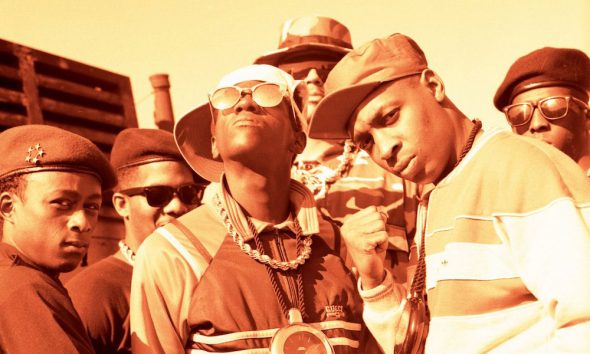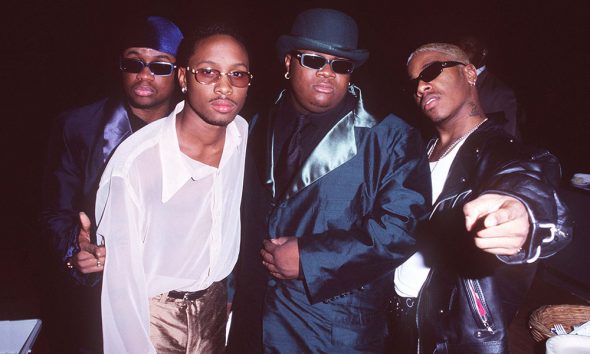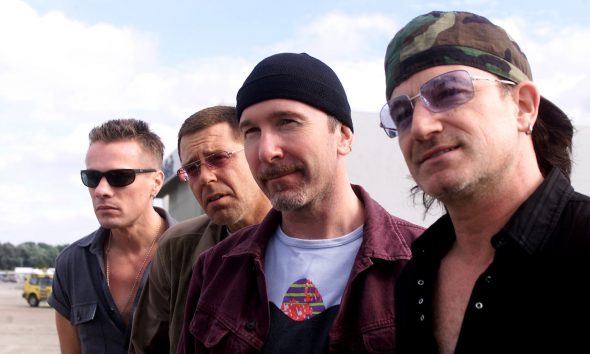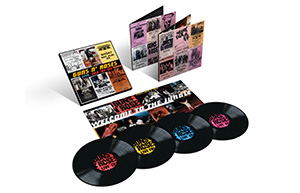The Real-Life Rock Legends Who Inspired ‘This Is Spinal Tap’
When the mockumentary ‘This Is Spinal Tap’ hit theaters, music fans laughed. But many rock insiders winced in recognition.

When filmmaker Marty DiBergi joined veteran UK rockers on their tour to promote their misunderstood masterpiece, Smell The Glove, he could never have imagined the decadence, debauchery, inter-band tension, and mime that he’d have the good fortune to document. On its release, his rockumentary This Is Spinal Tap not only brought us the sights, the sounds, and the smells of a hard-working rock band on the road, but it showed how Nigel Tufnel (guitar), David St Hubbins (vocals, guitar), and Derek Small (bass) fit into the lineage of classic rock. From controversial stage props to undignified bookings, DiBergi captured moments that were eerily reminiscent of pitfalls that Tap’s peers and predecessors had also faced. Coincidence(s)? You decide. As DiBergi would say, “Enough of our yakkin’, whaddya say? Let’s boogie!”
“Give Me Some Money”/“(Listen To The) Flower People”
Though This Is Spinal Tap follows the band in their hard-rockin’, tongue-waggling, spandex pants-straining pomp, they didn’t arrive fully formed. DiBergi winds the clock back to Tap’s beat group past with footage of a 1965 performance on British TV’s Pop, Look & Listen of their rapacious hit “Give Me Some Money.” Back then, they were known as The Thamesmen, with Joe “Stumpy” Pepys, nicknamed The Peeper, behind the drumkit. In the film, an emotional St Hubbins reveals that Pepys died in a bizarre gardening accident. “It was really one of those things,” adds a still-confused Tufnel. “The authorities said, well, best leave it unsolved, really.”
Fast-forward to 1967, and the newly christened Spinal Tap had ditched the suits, grown their hair, and embraced flower power. The enormous success of their psych-pop single “(Listen To The) Flower People” saw them tour “the world and elsewhere,” imploring audiences to pay attention to the new generation. Tap may never have quite worked out what the hippies were actually saying, but that’s by the by. For his film, DiBergi unearthed some prime footage of Flower People-era Tap from the U.S. TV show Jamboree, which is especially moving as it features drummer Peter James Bond, who exploded on stage during the band’s set at the Isle Of Lucy blues-jazz/jazz-blues festival, leaving — according to eyewitness accounts — nothing but a green stain on his drum seat.
The Tap were not the only hard-rockin’ English band to take their time to alight on the path of denim and leather. Blistering boogie merchants Status Quo first caught the eye as a mod beat combo with 1968’s UK No. 7 hit “Pictures Of Matchstick Men” before taking a trip for the psychedelic whimsy “Ice In The Sun.” Fortunately, they, like Tap, saw the error of their ways and, with 1971’s Piledriver on, became heads-down, heavy blues rockers in search of the fourth chord.
“Rock And Roll Creation”
While critics didn’t understand Tap’s foray into fretboard theology, The Gospel According To Spinal Tap (“What day did the Lord create Spinal Tap and couldn’t he have rested on that”), the album featured one of their most enduring songs, “Rock And Roll Creation.” The epic track ponders the beginnings of the universe and man’s insignificance in the wake of such magnificence. Unfortunately, in the performance DiBergi chose for This Is Spinal Tap, the song’s meaning is obscured somewhat by Smalls getting stuck in his cocoon stage prop. Roadies try to free Smalls, first with a hammer and then with a blowtorch — much to the annoyance of St Hubbins and Tufnel — but to no avail. Eventually, the bassist’s pod breaks free, but it’s too late; the song is over, and Smalls must return. Unfortunately, it closes early, trapping an arm but leaving the other one free for Smalls to raise a defiant fist to the crowd.
Smalls was one of many musicians to be trapped by his own stage equipment. During the North American leg of the Tales From Topographic Oceans tour (November 1973 to early 1974), prog giants Yes had a stage set that surrounded drummer Alan White with an extravagant fiberglass drum platform. At one show, the structure failed to open, leaving White trapped. Decades later, during the Oslo, Norway, show of U2’s 1997 Pop tour, the band got stuck inside a giant lemon. Somewhere, Derek Smalls was smiling to himself.
“Stonehenge”
Cancelled shows, confiscated cucumbers, empty in-store signings — times are tough for Tap as their tour continues. Still, the band know they have an ace up their sleeve in the pagan prog rock epic “Stonehenge,” an examination of the role of druids circa “before the dawn of time” in building the mystic landmark. After agreeing to resurrect the song, Tufnel hands manager Ian Faith a rough sketch of the stage prop — a simple reproduction of one of Stonehenge’s famous arches — including measurements.
When Faith meets with the artist he’s commissioned to build the model, he is stunned to find that it’s only 18 inches high. When he questions her work (“Are you telling me that this is it? This is scenery? Have you ever been to Stonehenge?”), the artist produces Tufnel’s original sketch, showing that he’d written inches instead of feet. Faith makes the executive decision not to inform the band, and when the monument is lowered at a crucial part of “Stonehenge,” the song descends into disaster, and the post-show investigation leads to Faith quitting.
Meanwhile, by complete coincidence, during Ian Gillan’s brief time as singer of Black Sabbath in 1983, the heavy metal pioneers had the opposite problem — their Stonehenge was too big. “We had Sharon Osbourne’s dad, Don Arden, managing us,” recalled bassist Geezer Butler. “He came up with the idea of having the stage set be Stonehenge. He wrote the dimensions down and gave them to our tour manager. He wrote it down in meters, but he meant to write it down in feet. The people who made it saw 15 meters instead of 15 feet. It was 45 feet high and it wouldn’t fit on any stage anywhere, so we just had to leave it in the storage area. It cost a fortune to make, but there was not a building on earth that you could fit it into.” In further echoes of Tap, when Gillan told Mojo the story in 1993, he recalled that the Stonehenge set was actually Butler’s idea. Perhaps we’ll never know.
“Sex Farm”
Following the “Stonehenge” misunderstanding and with tensions at a high point, the band reached their breaking point at an “at ease” show at the Lindberg Air Force Base, Seattle, booked by new manager Jeanine Pettibone-St Hubbins when the original show at the city’s Civic Arena was cancelled. This Is Spinal Tap shows the band being greeted by the fast-talking and slightly shaggy-haired (by his own admission) Lieutenant Hookstratten, who informs the band that he is a huge fan “of all of your records… I am not speaking of yours personally, but the whole genre of rock’n’roll.” Hookstratten also has a request: “Would you play a couple of slow numbers so I can dance?”
We see Tap launch into “Sex Farm,” a hard rocker which, according to Smalls, took a sophisticated view of the idea of sex (sample lyric: “Workin’ on a sex farm/Trying to raise some hard love/Getting out my pitchfork/Poking your hay”). The crowd looks puzzled, and the situation worsens when Tufnel’s wireless setup begins picking up local radio frequencies. In a fit of rage, Tufnel throws his guitar to the floor and storms off stage, but not before shooting a meaningful look at Pettibone-St Hubbins. Happily, when “Sex Farm” becomes an unexpected hit in Japan, Tufnel returns to the group for a triumphant tour.
Amazingly, Spinal Tap were not the first to find themselves in such a situation. English prog rockers Uriah Heep had a brush with the forces back in their early days. “Heep were in the position of trying to regain the popularity of the early 70s,” former keyboard player John Sinclair told 50gigsinaday. “We took any gigs that came our way to simply pay the bills.” Sinclair went on to reveal that This Is Spinal Tap “captured the pain of playing to a bunch of US airmen in uniform with their wives in evening dress. And we died!”














